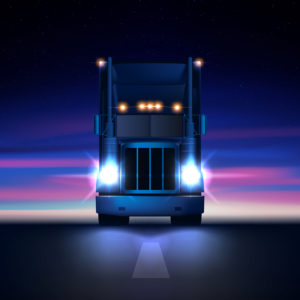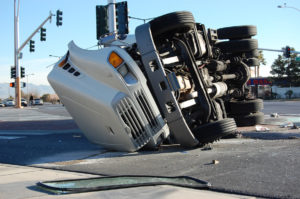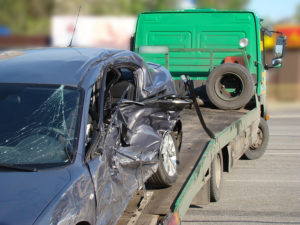 Across America, hundreds of thousands of trucks move large loads across the country every day. Each year, more than 4,500 truck drivers find themselves involved in fatal accidents, and in even more cases, passengers in other vehicles suffer serious injuries in truck accidents, with more than 116,000 people suffering injuries in 2017. As a driver, you can help decrease your risk of involvement in a serious truck accident by following basic road etiquette. If you have already been involved in truck accident contacting a skilled truck accident attorney can be beneficial for knowing your legal options.
Across America, hundreds of thousands of trucks move large loads across the country every day. Each year, more than 4,500 truck drivers find themselves involved in fatal accidents, and in even more cases, passengers in other vehicles suffer serious injuries in truck accidents, with more than 116,000 people suffering injuries in 2017. As a driver, you can help decrease your risk of involvement in a serious truck accident by following basic road etiquette. If you have already been involved in truck accident contacting a skilled truck accident attorney can be beneficial for knowing your legal options.
Potential Causes of Truck Accidents
A variety of causes can contribute to truck accidents. These may include:
- Driver distraction. Drivers who choose to pay attention to their cell phones, food, or distractions inside their trucks instead of the road can quickly cause an accident. In fact, driver distraction from external elements causes around 8 percent of truck accidents each year.
- Poor weather conditions. Truck drivers often must carry their loads across the country regardless of weather conditions. Some companies may require their drivers to continue driving even through stormy conditions, including conditions with both rain and ice. Other drivers may push their speeds in spite of unsafe conditions to help meet deadlines or achieve bonuses.
- Driver fatigue and inattention. Fatigued drivers simply cannot respond as effectively as awake, alert drivers. Not only that, sleepy drivers may struggle to keep their eyes open and their minds on the road. Driver fatigue contributes to around 13 percent of accidents per year.
- Trailers swinging out of control. Tractor-trailers consist of two key parts: the cab of the truck and the trailer attached to it. In a jackknife accident, the trailer swings around separately from the cab, leaving the truck driver struggling to control the vehicle. Often, jackknife accidents occur due to truck drivers attempting to stop their vehicles abruptly.
- Mistakes on the part of the truck driver. Truck drivers, like any other driver, can make mistakes behind the wheel. Unfortunately, because they drive much larger vehicles, their mistakes can cause exponentially more damage for other drivers who share the road with them. Truck drivers may fail to adequately follow the rules of the road, or they might lose track of what happens on the road around them. A simple error in judgment can result in a serious accident.
- Mistakes on the part of other drivers on the road. Many drivers struggle to safely share the road with large trucks. They may, for example, try to cut in front of truck drivers or stop abruptly in front of the truck without giving the driver adequate time or room to stop such a large vehicle. Drivers may also choose to sit in a truck’s blind spot, which can increase the risk of an accident, as the truck driver cannot see them. Other drivers may simply choose to disregard the rules of the road. Speeding, ignoring red lights and stop signs, or failing to yield to a large truck with the right of way can all cause accidents with substantial injuries.
- Mechanical failures. Big trucks require even more maintenance than smaller passenger vehicles. Often, drivers must go over the truck before and after each run to fulfill state or company requirements. That does not mean, however, that they always prevent mechanical failures. Tire blowouts, brake failures, and problems with the engine or transmission can all cause serious accidents for big trucks and the drivers who share the road with them.
- Improperly loaded freight. Big trucks often carry heavy loads. When the people responsible for loading the freight do not ensure proper loading, including a balanced load that is secured tightly, it may cause the load to shift abruptly, which can cause the truck driver to lose control of the vehicle.
Types of Truck Accidents
Truck accidents, like car accidents, can occur in the blink of an eye. The types of accidents may vary; all of them, however, can cause substantial injury to other drivers on the road, including traumatic brain injury, spinal cord damage, amputations, and organ damage. Below we discuss some of the different types of truck accidents.
Jackknife Accidents
Jackknife accidents occur when the trailer swings around out of control after an abrupt stop or overly forceful turn. In a jackknife accident, the trailer swings forward to create a V shape with the cab of the truck. Empty trailers may increase the risk of jackknife accidents, since they lack the weight needed to help keep the trailer on the road. Jackknife accidents may cause the driver to completely lose control of the vehicle. Other risk factors for jackknife accidents include:
- Wet or icy road conditions
- Roads with speeds over 55 mph
- Loads that shift abruptly
Drivers can help prevent jackknife accidents by taking turns and changing lanes slowly, avoiding excess speeds, and carefully checking cargo before heading out to ensure that the handlers secured it properly.
Blind Spot Accidents
Many big trucks, from tractor trailers to cement mixers, have large blind spots. Truck drivers often use a combination of mirrors to help decrease the size of their blind spots and make it easier to see other drivers around them; however, a driver who cannot see a truck’s mirrors remains invisible to the driver of the truck. Truck drivers typically do their best to pay careful attention to everything on the road around them, including the way other drivers move around them. Unfortunately, when small passenger vehicles spend too much time in a truck’s blind spot, the truck driver may lose track of them. Truck drivers may also fail to note drivers who pull into the trucks’ blind spots as they attempt to make a turn. Blind spot accidents can cause substantial damage to passenger vehicles as well as the truck.
Rollover Accidents

When a big truck rolls over, it often causes substantial damage both to it and to other vehicles around it. Truck rollover truck accidents can occur alone, especially if the truck’s wheels tip off of a sharp drop or the truck driver misses a turn. Truck drivers may also suffer rollover accidents involving other vehicles. In a truck rollover accident, the truck may land on top of a smaller passenger vehicle, causing substantial crushing damage to the vehicle and to passengers in it. Rollover accidents can make it very difficult to rescue drivers and passengers, since the bulk of the truck may land on top of the other vehicle. In some cases, rollover accidents quickly lead to death for vehicle occupants.
Wide Turn Accidents
Trucks require a great deal of space to make turns, especially right turns, since the driver cannot easily see the right side of the vehicle. When smaller vehicles creep into the space needed by the truck, the driver may never recognize their presence. As a result, wide turn accidents can lead to substantial damage to the other vehicle before the truck driver even recognizes its presence. Other drivers can help avoid wide turn accidents by staying out of trucks’ blind spots and paying careful attention to truck drivers’ signals. If a truck needs to turn right, passenger vehicles should wait to advance into that space until the truck has completed its turn.
Rear-End Collisions
In most cases, the rear vehicle in a rear-end collision causes the accident. Rear-end collisions often result from inattentive drivers who fail to take note of the car in front of them stopping or who do not brake adequately. In the case of big trucks, however, drivers of passenger vehicles may change lanes in front of the truck abruptly, without giving the big truck adequate stopping or slowing room. Many drivers simply do not realize how much room it takes to stop a big truck: at 65 miles per hour—which is normal highway traveling speed in many states—it can take 525 feet to come to a complete stop. For comparison, a football field spans 300 feet. Passenger vehicles, on the other hand, can come to a stop in just over 300 feet. The difference between the two stopping speeds can quickly lead to a rear-end collision, which may cause significant injury to passengers in the vehicle, since the truck often continues to travel at a high rate of speed.
Underride Accidents
Rear-end collisions occur when a truck hits the back of a passenger vehicle or another truck. In an underride accident, however, the passenger vehicle strikes the back of the truck. Because of its much smaller size—especially when it comes to small cars—the car slips under the back of the trailer. At high rates of speed, this can cause serious injury or fatality to the people in the car. Typically, underride accidents occur because drivers choose to travel too close to a big truck or ignore signs that the driver intends to stop, including visible brake lights. A lack of brake lights, however, can result in drivers who cannot predict the big truck’s need to stop, leading to an underride accident.
Tire Blowouts
Tire blowouts in big trucks cause just as much trouble and potential damage as tire blowouts in smaller passenger vehicles; in many cases, truck blowouts cause even more damage. When a tire blows out unexpectedly, the driver often loses control of the vehicle. Because of the truck’s larger mass, it can continue to move at a high rate of speed. Attempts to stop the vehicle may cause it to move even further out of control. In the event of a tire blowout, the truck driver may not have enough control to avoid other vehicles on the road. Due to the truck’s unpredictable behavior, drivers may have more trouble getting out of the way.
T-Bone Accidents

Like other vehicles, when trucks run a red light or travel through an intersection without slowing for other vehicles, they can strike directly in the middle of another vehicle, creating a “T” shape with the other vehicle. T-bone accidents can cause devastating injury to the passengers in the other vehicle, especially the ones on the damaged side of the vehicle.
Improperly Loaded Trucks
Properly loading cargo makes a big difference in how a truck handles its load and travel. With an improper load, not only can shifting cargo make it difficult to control the vehicle, but also cargo may fall off the vehicle, causing significant hazards to other vehicles on the road. In some cases, falling cargo can cause an accident, if other drivers cannot get out of the way fast enough or the cargo strikes another vehicle.
Dangerous cargo doesn’t have to be in solid form. In the case of concrete trucks or tanker trucks, especially tanker trucks carrying hazardous chemicals, a spill can cause just as much damage as more solid cargo. Spilled liquids or concrete on the road can cause slick surfaces or can destroy visibility for drivers behind the truck.
Head-On Collisions
Truck drivers attempt to avoid other drivers on the road, including those who may make foolish decisions. Unfortunately, both truck drivers and other drivers may make driving errors that lead to head-on collisions. When one driver drifts out of the appropriate lane for that vehicle, whether the truck crosses lanes or the other vehicle makes it out of its assigned lane, it can cause a head-on collision. These accidents often cause significant injury or death for the passengers in the other vehicle, especially because the size and speed of the truck increases the impact force on the other vehicle.
If You Need More Information, a Truck Accident Lawyer Can Answer Your Questions

Regardless of the cause of the accident, accidents with big trucks may cause substantial injuries and damage to other vehicles. If you or someone you love suffered serious injury in an accident with a big truck, you may need an attorney to help you seek the compensation you deserve. Contact an attorney as soon as possible after your accident so that your attorney can start building a case. The sooner you seek legal aid, the sooner you can start the claims process. The right attorney can help maximize your potential compensation.